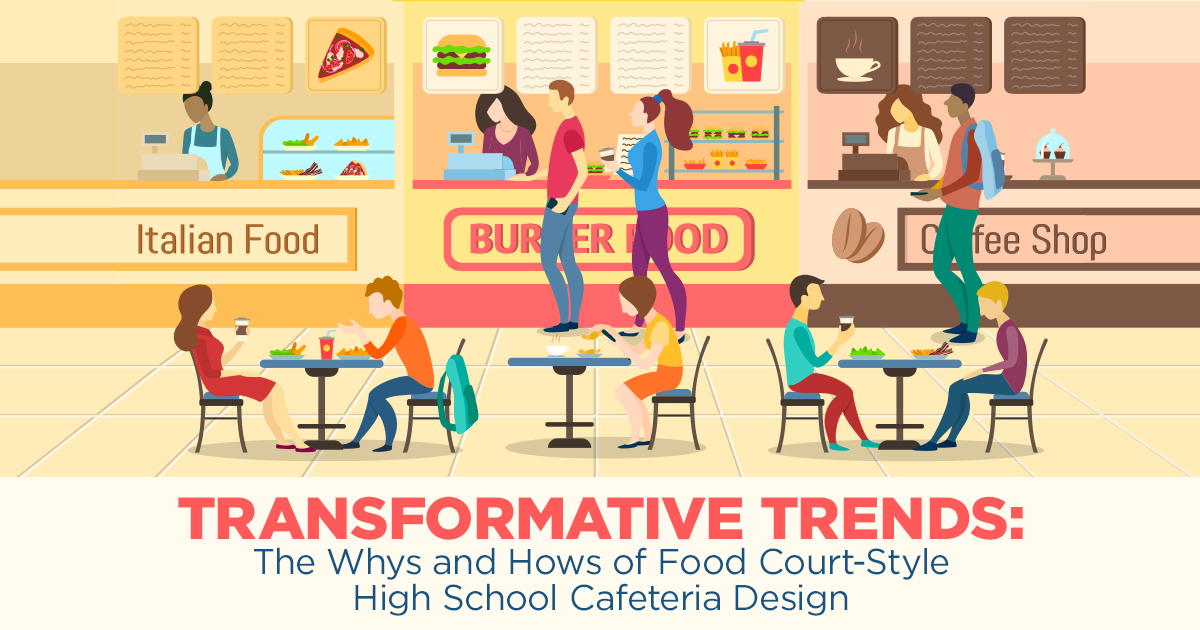Check out this cafeteria transformation at Yulee High School in Nassau County Florida by LTI.
Transformative Trends: The Whys and Hows of Food Court-Style High School Cafeteria Design

Gone are the days of the clichéd image of a lunch lady ladling out mashed potatoes on her student’s plates. It’s a new era in school dining, with a fresh perspective and a departure from the ordinary.
In recent years, high schools across the nation have undergone a transformative shift in cafeteria design, moving away from traditional layouts to embrace the concept of a high school food court. This change isn’t about being over-the-top; it’s a collective effort to enhance the overall dining experience for students, fostering spaces that are both engaging and inclusively dynamic.
Let’s explore some reasons behind the rise in food court-style high school cafeterias and uncover the key design principles steering this transformative trend.
The whys: reinventing high school cafeterias
Enhancing socialization and community building
One of the primary motivations behind adopting a food court-style design in high school cafeterias is to create a conducive environment for socialization and community building. High schools with food courts aim to break down traditional barriers and provide students with a space that encourages interaction among diverse groups. This fosters a sense of inclusivity and unity, contributing to a positive overall school culture.
Promoting healthy eating habits
As high schools strive to redefine their dining spaces and prioritize student well-being, the integration of expert solutions becomes fundamental. One such leader in cafeteria design is LTI, whose expertise in crafting modular food courts has become a foundation for schools aiming to revitalize their culinary offerings.
Incorporating LTI’s expertise allows high schools to curate a diverse array of culinary choices, emphasizing healthier options to foster balanced nutrition. This strategic move mirrors an increasing recognition of the pivotal role dietary habits play in influencing students’ holistic well-being. Introducing an enticing environment with a variety of nutritious selections, schools aim to instill positive eating habits that contribute to students’ overall health and extend beyond the classroom setting.
Catering to diverse preferences
The food court model allows for a diverse range of culinary offerings, accommodating the student body’s varied preferences and dietary requirements. From ethnic cuisines to vegetarian and vegan options, high school food courts strive to provide something for everyone. This inclusivity not only reflects the broader cultural diversity within schools but also ensures that every student has access to meals that suit their tastes and dietary needs.
The hows: design principles for high school food courts
Zone-based layouts
High school cafeterias adopting a food court-style design often feature a zone-based layout. This involves creating distinct sections for different types of cuisine, such as a pizza station, salad bar and international cuisine corner. This layout promotes an organized and efficient flow, allowing students to navigate through various food options easily.
Aesthetically pleasing ambiance
The aesthetics of the cafeteria also play a role in attracting students and creating a welcoming atmosphere. For instance, LTI’s VisionDesign service ensures the aesthetics of the cafeteria align with the latest trends and student preferences. Vibrant colors, modern furniture, custom signs/wall treatments and ample natural light are seamlessly integrated into the design, creating a visually appealing space that enhances the overall dining experience. High school cafeteria design focuses on incorporating elements that make the dining area an enjoyable place for students to relax and connect with their peers.
Technology integration
To streamline the ordering and dining experience, many high school food courts leverage technology. Touchscreen kiosks, mobile ordering apps and cashless payment systems are becoming commonplace. These innovations not only enhance efficiency but also align with the tech-savvy preferences of today’s students.
Imagine a cafeteria where every bite is a step towards a healthier lifestyle, and every table is a hub of diverse conversations. As high schools across the nation embrace food court-style designs, the educational landscape undergoes a transformation that goes beyond academics, fostering the holistic development of students. It’s not just a change; it’s an evolution toward an educational experience that’s as dynamic and diverse as the students it serves.


